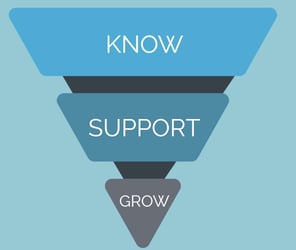Does your customer service software help you measure customer expectations? Understanding the relationship between customer expectations and customer satisfaction is crucial to business success. Companies must grasp, understand, and manage customer expectations effectively in order to deliver experiences that meet or exceed them. When they do, businesses can use that momentum to enhance customer satisfaction, build stronger customer relationships, and drive business success.

What’s The Benefit Of Focusing On Customer Satisfaction?
When your customers are happy, they tend to pay more money for your products and services, creating a sense of loyalty. Your most loyal customers are those who are most familiar with your brand. They present an opportunity to introduce upsells to products, add new features to products, include a subscription plan to further engage them.
Customer Expectations vs. Customer Satisfaction
When it comes to integrating customer service software into your business, it’s important to note that customer expectations and customer satisfaction are closely related. Customer expectations are defined as the set of assumptions, beliefs, and desires your customers bring to your business. These expectations can be based on previous experiences with your company, recommendations from friends and family, marketing campaigns, and the perceived value of your product or service.
Customer satisfaction refers to the level of which your customers express fulfillment, pleasure, or happiness with the experience they have with your product, service, or brand. The customer is making an evaluation of your products and services based on perceptions and lived experiences.
When your business surpasses customer expectations, the customer is satisfied. However, if you fall short of expectations, or the experience is not what the customer anticipated, the customer is left dissatisfied.

Companies should concern themselves with how to create positive customer experiences because they want to avoid high customer churn or attrition. Research shows that 1 out of 26 customers actually complain about poor buying experiences while the rest say nothing at all. That means unless a company has a process to get to know what their customers are thinking and feeling about their products and services, they may never know the full story.
Get To Know Your Customers Better – And Their Full Story
Shifting your company’s focus to getting to know your customers and the experiences they have with your product, services, or brand will require a change in mindset about what is most valuable to your overall success. And while most companies will say that customers must come first, there may not always be an understanding of what that actually looks like.
TeamSupport’s Customer Pipeline strategy reviews the entire customer journey in your business. It offers an opportunity to deliver positive, data-backed decisions on how to serve your customers based on their expectations and satisfaction. It involves a 3-step process that ensures you know your customer, support them in effective ways, and grow with them.

Know
To “know” requires an analysis of the foundation of your customer relationship. This involves looking at several metrics like the Net Promoter Score (NPS), Customer Satisfaction score (CSAT), and an index of customer distress. These metrics are taken into account along with stories pertaining to the customer goals – why is the customer using the product to begin with? This gives a well-rounded look into your customer needs and expectations.
Support
Next is to create a system of “support” within the Customer Pipeline strategy. Most businesses have some kind of support available within their product or service. Unfortunately though, most of these support systems are built as an afterthought; they don’t anticipate the needs of the customer.
The Customer Pipeline strategy allows the business to proactively solve problems and produce true value for their customers. Instead of merely putting out fires, which can lend itself to poor experiences, support teams can make decisions based on what they “know” about the customer and ensure they meet expectations before problems arise.
By offering multiple, preemptive ways to support the customer (community forums on the site, chatbots, how-to videos, and more), your support team is likely to provide exceptional customer experiences that leave customers satisfied.
Grow
The “grow” step in the Customer Pipeline strategy involves ensuring that your customers deeply understand how to use the product and are closely tied to it. In turn, you grow with your customers because there are more opportunities for upsell and cross-sell. The “grow” step happens when your customers are highly satisfied because all of their expectations have been met or exceeded.
Better manage customer expectations with TeamSupport
The best way for companies to be able to compete in today’s economy is to exceed customer expectations. As technology becomes more complex, the expectations placed upon your customer support team is only going to become more demanding. You’re either meeting expectations, exceeding them, or falling short of them. If you’re failing to meet customer expectations, then you face the risk of raising your customer churn rate. It is now essential for your business to have a strategy in place to help you understand your customer wants and needs.
Looking For Startup Consultants ?
Call Pursho @ 0731-6725516
Telegram Group One Must Follow :
For Startups: https://t.me/daily_business_reads







